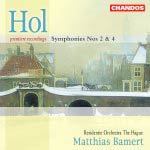
Hol, Richard - Symphonies Nos 2 & 4
 $35.00
Out of Stock
$35.00
Out of Stock6+ weeks add to cart
Hol, Richard - Symphonies Nos 2 & 4
Residentie Orchestra The Hague, Matthias Bamert
[ Chandos Classics / CD ]
Release Date: Sunday 30 September 2001
This item is currently out of stock. It may take 6 or more weeks to obtain from when you place your order as this is a specialist product.
Both works on this disc are premiere recordings
Matthias Bamert conducts the Residentie Orchestra The Hague in the second volume of works by Hol as part of Chandos' ongoing series of Dutch music.
Both works on this disc are premiere recordings and Hol's Symphony No. 4 is performed from a score newly edited for this recording.
Leading up to the Residentie Orchestra's centenary in 2004, this is the fourth disc in their series on Chandos which explores unfairly neglected Dutch repertoire of the last two centuries.
The strong bond between Dutch and German music, which prevailed right up until the first decade of the twentieth century, is apparent in Hol's works where the influences of Schubert, Mendelssohn and Schumann in particular may be heard.
Both works on this disc are premiere recordings
Richard Hol was hailed as an exceptionally gifted composer, conductor, organist, pianist and educator and played an important role in Dutch musical life during the second half of the nineteenth century.
Hol's Symphony No. 2 in D minor, composed in 1866, consists of four movements. The introduction, Lento, to the first movement is sombre and foreboding. Much of the thematic material seems influenced by the music of Weber and Mendelssohn, and the development section at times hints at Tchaikovsky. The atmosphere of the second movement, Preghiera, resembles that of the instrumental and vocal prayers of Liszt and Rossini. In the Presto scherzo we are reminded of one of Hol's first musical loves: the fairytale music of Mendelssohn. The Allegro con brio finale demonstrates an engaging vivacity and energy which proved popular with Hol's audiences.
Symphony No. 4 in A major bears no opus number but was completed in the spring of 1889. Despite the fact that Hol was at the peak of his career at the time of its composition, it appears that the symphony was never performed. Although one source points to a performance in 1891 no material from it survives, nor was the symphony ever published. For this recording the autograph score has been edited by the Residentie Orchestra The Hague together with musicologist Robbert van Steijn. The symphony's slow introduction serves as an atmospheric curtain-raiser to the ardour of the Allegro moderato. Some reminiscences of Dvoràk, whose symphonies Hol conducted, may be detected in both the second theme of the first movement and the trio section of the second movement. The masterfully orchestrated third movement hints at the music of Brahms, especially in the reprise. The finale, Allegro vivace, as in HolÕs other symphonies, is typically festive and exuberant.
Chandos' first volume of works by Hol, performed by Matthias Bamert and the Residentie Orchestra The Hague, received high praise:
'Matthias Bamert is just the man for such material… The Haag players would appear to be enjoying themselves: The music bounces along in the faster movements and glows with real warmth in the slower ones. The recorded sound is as good as Chandos has led us to expect…'
Fanfare
'Matthias Bamert and the Hague Residentie Orchestra are obviously persuaded by them [the works of Hol] and engage our sympathies too. Excellent, well-balanced Chandos sound in the best traditions of the house.'
International Record Review
'The music is fresh, unpretentious, well crafted and falls easily on the ear, especially in this sympathetic performance.'
Gramophone
Tracks:
Symphony No 2 Op 44
Symphony No 4